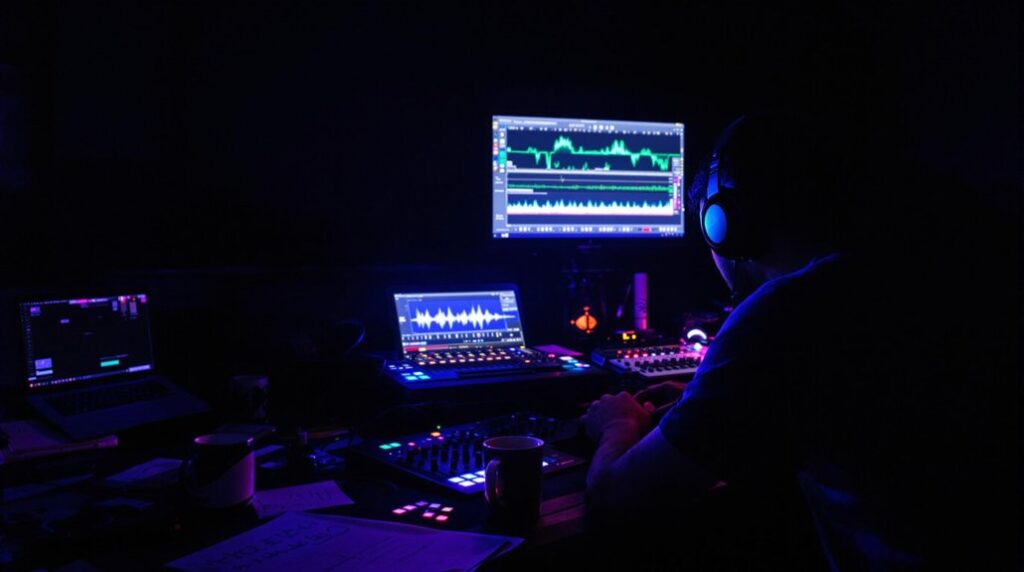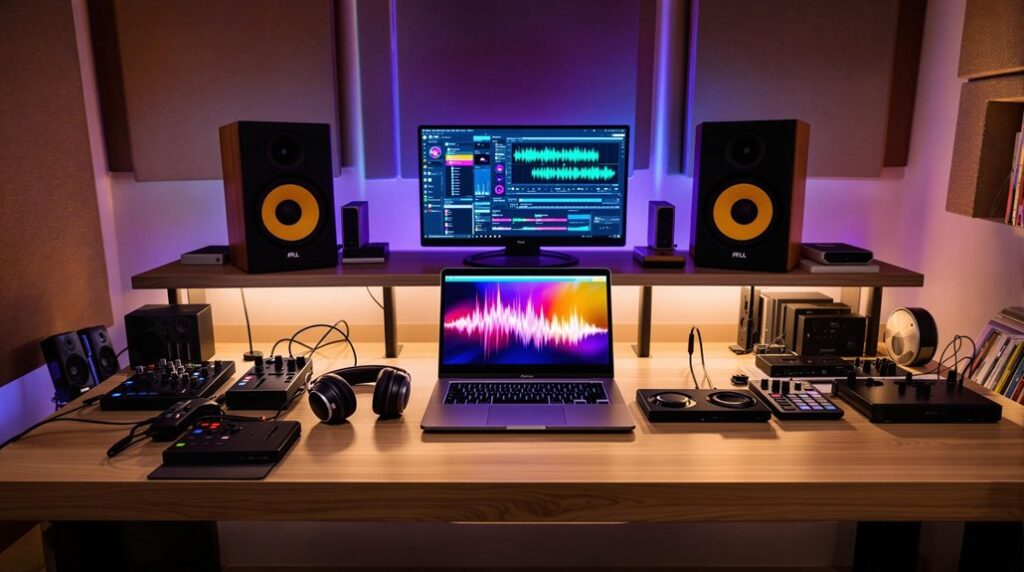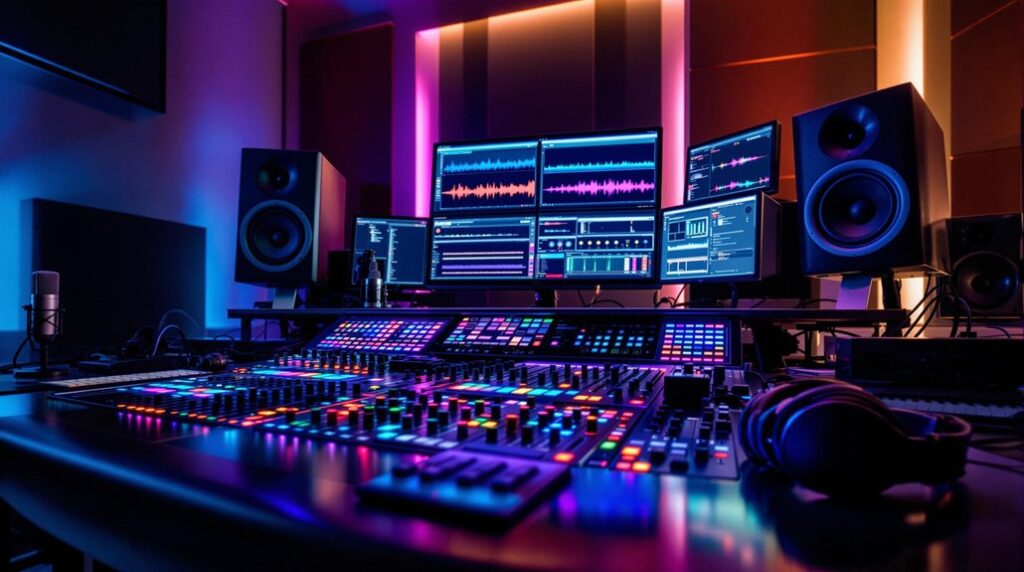To create space in your mix, use panning techniques to position sounds within the stereo field. Center essential low-frequency elements like bass and kick drums. Spread higher-frequency elements, like cymbals and hi-hats, to maintain balance and width. Use complementary panning to avoid frequency clashes by placing conflicting sounds on opposite sides. Employ hard panning for doubled instruments to enhance separation and clarity. Dynamic panning via automation adds movement and depth. Always check your mix in mono to prevent phase issues. Experimenting with these practices guarantees a more coherent and spacious mix. Understanding these methods can greatly impact your mix’s coherence and depth.
Key Takeaways
- Center low-frequency sounds to maintain a solid foundation and prevent clutter.
- Hard-pan doubled instruments to widen the mix and enhance stereo imaging.
- Use complementary panning to place conflicting frequencies on opposite sides and avoid muddiness.
- Employ dynamic panning automation to create movement and depth in the mix.
- Check mono compatibility frequently to ensure balanced and clear playback on all systems.
Understanding Panning Basics
Panning, a fundamental technique in audio mixing, controls where each sound sits in the stereo field, ranging from left to right. Employing effective panning strategies is essential for achieving spatial positioning and mix clarity. By distributing various elements across the stereo spectrum, you can avoid clutter and create a well-balanced, immersive soundscape.
The first step in mastering panning is understanding its impact on spatial positioning. For instance, placing low-frequency sounds like bass and kick drums in the center anchors the mix, providing a solid foundation. Higher-frequency elements, such as cymbals and high-hats, can be spread out to enhance the stereo width. This separation not only improves mix clarity but also allows each instrument to shine without competing for the same sonic space.
Creative applications of panning can further enrich your mix. Experiment with panning duplicate tracks or complementary instruments to opposite sides. This technique, known as stereo widening, produces a fuller and more dynamic sound. Subtle adjustments, like softly panning background vocals or ambient effects, can add depth and dimension without overwhelming the primary elements.
Hard Panning Techniques
When you use hard panning, place elements like background vocals or percussion entirely on one side to enhance stereo width and avoid frequency clashes. This technique helps balance instrument placement and creates a more immersive mix.
Balancing Instrument Placement
Critical panning instruments fully to the left or right can instantly create space and clarity in your mix. By utilizing critical panning, you enhance stereo imaging, allowing each instrument to occupy its own distinct place within the stereo field. This technique is particularly effective for achieving instrument separation, ensuring that sounds don’t overlap or clash within the mix’s frequency spectrum.
When you critically pan elements like heavy electric guitars or synths, you effectively widen the mix, providing a clear delineation between instruments. This separation not only prevents clutter but also highlights individual instrument characteristics, making them more discernible to the listener.
By experimenting with critical panning doubled instruments, you can achieve a fuller and more dynamic mix. For instance, panning two identical guitar tracks critically left and right can create a powerful and expansive sound.
Strategic implementation of critical panning also enhances depth, as it allows you to place instruments in specific locations within the stereo field. This balanced placement is essential for maintaining a cohesive mix where each element is audible and retains its unique sonic identity.
Ultimately, critical panning is an essential tool in your mixing arsenal for achieving a polished, professional-sounding track.
Creating Stereo Width
Frequently, you can achieve remarkable stereo width by hard panning instruments fully to the left or right, creating distinct separation and clarity in your mix. This technique, part of effective panning strategies, leverages stereo imaging to give each element its own space in the mix. By placing sounds entirely in one channel, you prevent frequency clashes and open up your mix, enhancing both spatial positioning and mix depth.
Experiment with hard panning doubled instruments like guitars or synths. For instance, pan one guitar hard left and its double hard right. This creates a fuller, more immersive sound. Similarly, you can apply this technique to backing vocals or layered synths, achieving a balanced feel while avoiding clutter.
Hard panning isn’t just about separation; it also contributes to a more dynamic and engaging listening experience. By carefully choosing which elements to pan hard left or right, you can craft a wide and expansive soundscape. This approach secures each instrument has its own distinct place, making your mix sound professional and polished.
Implementing these hard panning techniques effectively will enhance your overall stereo imaging and enhance the depth of your mix.
Complementary Panning
Have you ever wondered how to create more space and clarity in your mix by strategically positioning your instruments?
Complementary panning is a technique where you place sounds with conflicting frequencies on opposite sides of the stereo field to prevent clashes. This strategy helps you achieve separation and clarity by guaranteeing each element occupies its own space, enhancing spatial depth and improving stereo imaging.
When employing complementary panning strategies, you’re addressing frequency conflicts that often arise between instruments sharing similar frequency ranges, such as guitars and keys. By panning these instruments to opposite sides, you can avoid muddiness and create a more balanced mix.
For instance, if you have two guitar tracks that occupy the same frequency range, panning one to the left and the other to the right can effectively separate them, allowing each to be heard distinctly.
Experimenting with complementary panning not only enhances the overall width and depth of your mix but also maintains a cohesive sound. This technique ensures that each element complements the others, contributing to a more polished and professional mix.
Try it, and you’ll notice an immediate improvement in your mix’s clarity and definition.
Panning Conventions
Understanding panning conventions is essential for achieving a balanced and cohesive mix in your music production. Historically, panning has dictated the standard positioning of instruments within the stereo field to create a natural and immersive listening experience.
For instance, drums are often panned from the drummer’s perspective, placing the hi-hat slightly to the left and the floor tom to the right. This practice leverages panning psychology, making the mix feel more intuitive and authentic.
Guitars are typically panned left and right to generate a wide sonic landscape, allowing other elements like vocals to shine in the center. Vocals are usually centered to maintain focus and clarity, anchoring the mix. These conventions have evolved over time, yet they remain foundational for creating a well-balanced track.
However, don’t shy away from unconventional practices. Experimenting with non-traditional panning can introduce new textures and dynamics to your mix. Just be mindful of the overall balance.
Evolving trends in music production often challenge historical panning norms, pushing the boundaries of creativity while still respecting the core principles that safeguard a cohesive sound. By mastering these conventions and knowing when to break them, you’ll craft mixes that are both innovative and well-grounded.
Dynamic Panning
Expanding on the foundation of panning conventions, dynamic panning introduces automation to create movement and depth in your mix. By automating the movement of sound sources across the stereo field, you can add excitement and variation to your tracks. This technique involves dynamically shifting the position of instruments, which can emphasize specific parts of a song and keep listeners engaged.
Dynamic panning is essential for enhancing the spatial perception of your mix, giving it a sense of movement and depth. Here’s how you can effectively implement it:
- Automate panning of secondary elements, like percussion, to create dynamic movement.
- Gradually shift lead vocals or instruments during build-ups to increase intensity.
- Use abrupt panning changes for surprise elements or transformations.
- Pan effects, like reverb and delay, to different positions to create a more immersive environment.
- Experiment with LFOs (Low-Frequency Oscillators) to achieve subtle, continuous panning changes.
Mono Compatibility
Guaranteeing mono compatibility is crucial for your mix to sound balanced and clear on all playback systems. Mono playback systems, such as those found in clubs and older devices, can often reveal phase cancellation issues that aren’t apparent in stereo.
When you’re working on your stereo mixdown, use mono monitoring to check how your mix translates. This practice helps you identify and correct any elements that might disappear or sound imbalanced due to extreme panning.
Extreme panning can cause certain sounds to drop out or lose presence in mono playback, disrupting the stereo balance you’ve worked hard to achieve. To maintain a consistent listening experience across all systems, employ panning techniques that ensure clarity and balance in both stereo and mono environments.
For instance, avoid hard panning essential elements like vocals or bass, as their absence in mono could have a significant impact on the mix’s overall sound.
Checking Different Systems
To achieve a well-balanced mix, monitor your tracks on various sound systems like headphones, car stereos, and studio monitors to guarantee they translate accurately across different playback devices. Testing your mix on different sets of equipment is important for identifying potential issues in stereo imaging and ensuring a consistent listening experience.
Using headphones for mix monitoring provides you with accurate panning feedback, allowing precise adjustments to create a balanced stereo image. Car stereos and other consumer playback systems can reveal how your mix will sound to the average listener, making sure that the panning decisions hold up in real-world scenarios. Studio monitors, on the other hand, offer a flat frequency response, helping you make critical decisions without coloration.
Here are some key points to consider when testing your mix:
- Headphones: Ensure accurate stereo imaging and detailed panning adjustments.
- Car stereos: Test how your mix translates in a typical listening environment.
- Studio monitors: Use for critical listening and making unbiased adjustments.
- Mono testing: Detect phase issues or imbalances that mightn’t be apparent in stereo.
- Club systems: For electronic music, guarantee the mix remains cohesive and impactful on bass-heavy systems.
Stress-Free Panning
In Stress-Free Panning, you’ll simplify pan adjustments to achieve balance and clarity in your mix.
Effective panning techniques involve placing elements strategically in the stereo field to avoid frequency clashes and harsh sounds.
Simplifying Pan Adjustments
Simplifying pan adjustments involves making subtle, deliberate changes to element positions to achieve a balanced and clear mix. By focusing on panning precision and spatial awareness, you can create smooth adjustments and guarantee every element sits perfectly in the stereo field.
To maintain a stress-free panning experience, it’s vital to make small, incremental changes rather than drastic shifts. This method helps in avoiding disorientation and preserves the integrity of your mix.
Here are some key practices for simplifying pan adjustments:
- Start with centering: Begin by placing the most important elements, like vocals and bass, in the center.
- Gradual panning: Make subtle modifications to other elements, moving them slightly left or right to create space.
- Check in mono: Frequently switch to mono to make sure your mix maintains balance and clarity when collapsed.
- Use reference tracks: Compare your mix with professionally mixed tracks to assess spatial distribution.
- Balance frequencies: Pay attention to frequency content; ensure that no single side becomes too heavy or light.
Effective Panning Techniques
Building on the foundation of simplified panning adjustments, let’s explore effective panning techniques that guarantee a stress-free mixing process.
Start by experimenting with hard-panning doubled instruments. This method creates a fuller, wider mix, enhancing spatial separation and providing a clear, distinct soundstage. Complement this with panning automation to introduce movement in your mix, adding spatial depth and keeping listeners engaged.
Use complementary panning techniques to balance your mix and prevent frequency clashes. For instance, if you pan a guitar to the left, consider panning a keyboard to the right. This ensures a balanced feel and avoids the overcrowding of certain frequencies.
To achieve a professional sound, adhere to industry norms but don’t hesitate to make intentional mix alterations to suit your artistic vision.
Creating an illusion of dynamic range can be achieved by panning elements narrowly in verses and widening them in choruses. This technique enhances the overall listening experience by distinguishing different parts of the song.
Lastly, aim for a pleasant and immersive experience akin to surround sound. Avoid overdoing any one panning location to maintain a balanced mix, ensuring each element contributes effectively to the final output.
Genre-Specific Panning
Different music genres employ specific panning techniques to enhance clarity, depth, and spatial dynamics in a mix. Understanding how to use these techniques effectively can enhance your mix to a great extent.
Let’s explore some genre-specific panning strategies:
- Panning in hip hop: Place the kick and bass in the center to anchor the beat, while panning hi-hats and snares slightly to the sides to create width.
- Best practices for pop: Keep vocals in the center to maintain focus, while panning backing vocals and harmonies wide to add depth and richness.
- Rock and metal: Hard-pan heavy electric guitars left and right to create a wide mix, preventing muddiness in the center and giving each instrument space.
- EDM and electronic: Wide panning of synths and effects enhances the stereo image, creating a spacious and immersive mix.
- Jazz and orchestral: Center saxophones and brass instruments to maintain focus and presence, ensuring the main elements are clear and prominent.
Minimalist Panning
While genre-specific panning techniques can enhance your mix’s spatial dynamics, minimalist panning focuses on keeping fewer elements panned to maintain a spacious and uncluttered stereo image. By applying panning precision, you can guarantee that only the most essential elements occupy specific positions in the stereo field. This approach promotes a minimalist mix, allowing each sound to be clearly heard without competing for space.
Minimalist panning greatly contributes to spatial clarity by preventing clutter and frequency clashes. When fewer elements are panned, there’s less risk of overlapping frequencies that can muddy your mix. This creates a focused sound, where each element is distinct and well-defined. Additionally, a minimalist mix allows you to control and intentionally place sound sources, making your mix more cohesive.
Experimenting with minimalist panning can lead to a cleaner and more impactful mix. Start by identifying the core elements of your track that require panning. Typically, these might include lead vocals, main instruments, or critical effects. By limiting panning to these key components, you can achieve a balanced and spacious mix that enhances the listening experience.
Frequently Asked Questions
How to Create More Space in a Mix?
To create more space in a mix, you should apply EQ techniques to carve out frequency ranges for each instrument. Adjust reverb settings to add depth and separation, ensuring each element occupies its unique sonic space.
How to Mix With Panning?
To mix with panning, position instruments using precise panning techniques to create stereo width. Center low-frequency sounds and pan high-frequency sounds to the sides. This approach prevents frequency clashes and guarantees a balanced, spacious mix.
How to Make Separation in Mix?
To achieve frequency separation and enhance dynamic range, use EQ to isolate frequencies of each instrument. Then, apply panning to distribute them across the stereo field. This method prevents clashes and creates a balanced, spacious mix.
Why Is Panning Important in Mixing?
Panning is essential in mixing because it enhances stereo balance and spatial awareness. You can prevent frequency clashes, improve clarity, and achieve a more immersive listening experience by placing instruments and vocals strategically in the stereo field.
Conclusion
By mastering these panning techniques, you’ll create a mix with depth and clarity. Remember to experiment with hard and complementary panning, follow conventions, and consider dynamic panning for movement.
Always double-check your mix on different systems to guarantee consistency. Adapt your approach based on genre and aim for a minimalist style when necessary.
With practice, you’ll achieve a balanced, professional sound that enhances every element of your mix.




